Do you want to learn options trading to maximise returns from S&P 500 ETF?
We'll show you the Wheel Strategy to multiply profits from S&P 500 index.
Contents
- Why Invest in S&P 500 ETF?
- What Is the Wheel Strategy?
- Which S&P 500 ETF Is Most Suitable for the Wheel Strategy?
- 3 Steps to the Wheel Strategy
- How to Set the Strike Prices of Put and Call?
- Expected Returns of Trading the Wheel Strategy With SPY
- Differences Between Holding SPY ETF and the Wheel Strategy
- Best Value Stocks for the Wheel Strategy
Why Invest in S&P 500 ETF?
Most experienced traders recognise Standard & Poor's 500 index as the most iconic index fund in the world. It tracks the performance of 500 most profitable companies in the US stock market.
Companies included in the S&P 500 make up around 80% of the total market capitalisation, is widely regarded as the best gauge of large-cap U.S. equities, and a favourite among passive investors.
Most people expect an annual return of 9% from buying and holding ETFs that track the S&P 500 index.
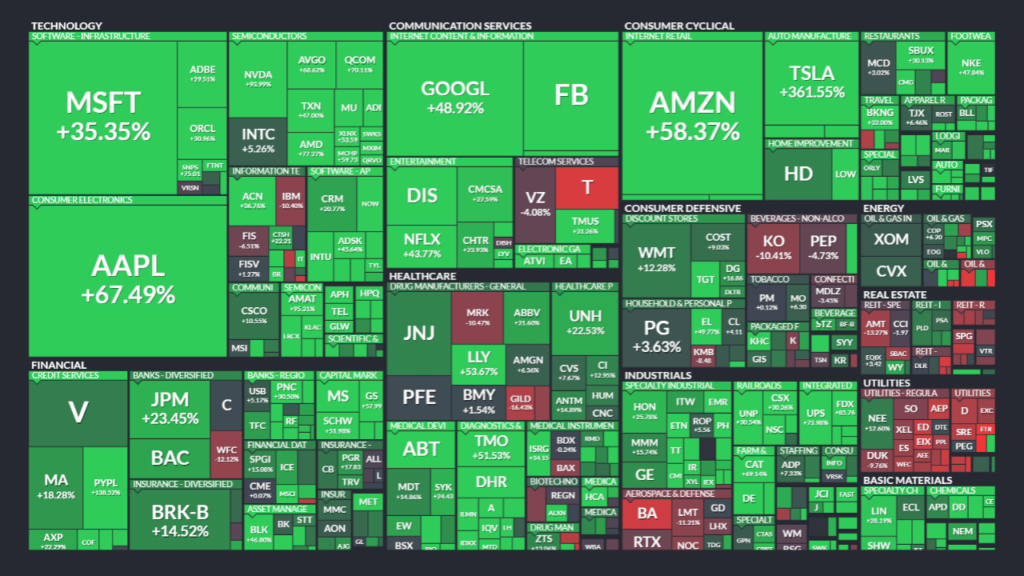
Some of the most dominant companies in the world, such as Apple, Google, Facebook, Netflix, Disney are included in the index. Tesla was also included in the S&P 500 index for the first time in December last year.
Investing in an S&P 500 ETF is a diversified way of purchasing stocks from all these companies at the same time.
What Is the Wheel Strategy?
The Wheel Strategy is a set of steps to combine trading options with stocks to increase the return overs the traditional buy-and-hold strategy.
An expert options trader knows that selling options is most profitable when the underlying doesn't fluctuate a lot, which makes the Wheel Strategy perfect for S&P 500 ETFs that are well diversified and prices don't change suddenly.
Which S&P 500 ETF Is Most Suitable for the Wheel Strategy?
There are 3 popular ETFs that track the S&P 500, which are SPY, IVV and VOO. The 3 ETFs have different tracking accuracies, different management fees, so you might wonder which one is most suitable for the Wheel Strategy.
Since the Wheel trading strategy uses options to boost the returns on investing the underlying for the long-term, we choose the best ETF by the volume of options traded for each ETF.
| S&P 500 ETF | Daily options volume |
|---|---|
| SPY | 2,272,620 |
| IVV | 253 |
| VOO | 111 |
By comparing the options volume for each of the 3 ETFs, we can tell SPY has exponentially more options liquidity than the other 2. So we will choose SPY as the symbol for trading the Wheel Strategy.
3 Steps to the Wheel Strategy
The Wheel Strategy is a sequence of repeatable steps that we can use to combine selling options with holding stocks to buy low and sell high the SPY ETF.
The 3 steps of the SPY options strategy depend on the number of shares you hold:
- Sell a Cash-Secured Put when holding 0 shares.
- Sell a Strangle (a Put and a Call) when holding 100 shares.
- Sell 2 Call options when holding 200 shares.
1. Sell a Cash Secured Put When Holding 0 Shares
When we do not own any SPY stock, we can sell a Cash-Secured Put that expires in 30 days.
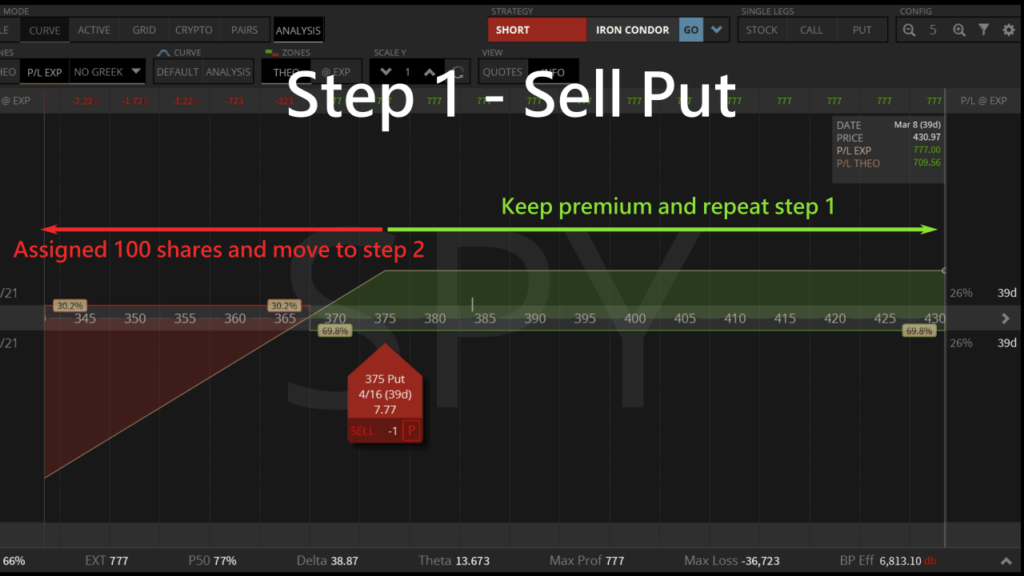
If SPY does not drop below the strike price after 30 days, we will collect all the premium from the trade.
If SPY price drops below the strike price, we will be assigned 100 shares of SPY at a discount. Then we move on to the next step.
2. Sell a Strangle When Holding 100 Shares
Now we own 100 shares, we can sell a Strangle that expires in 30 days, which is a combination of a Cash-Secured Put and a Covered Call.
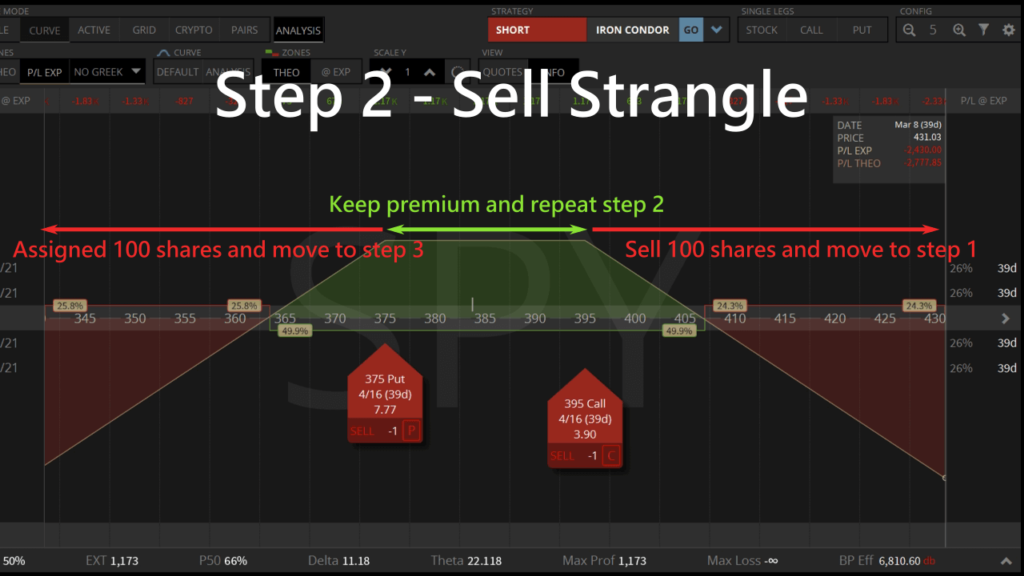
If the SPY price stays within the 2 strike prices after 30 days, we collect all the premium from selling options.
If the SPY rises beyond the Call strike, we will be forced to sell the 100 shares at a high price. Then we move back to step 1.
If the SPY price drops below the Put strike, we get to purchase another 100 shares at an even lower price. Then we move forward to step 3.
3. Sell 2 Covered Call Options When Holding 200 Shares
Now we own 200 shares of SPY ETF, we can sell 2 Covered Call options at the same time to earn twice the amount of premium.
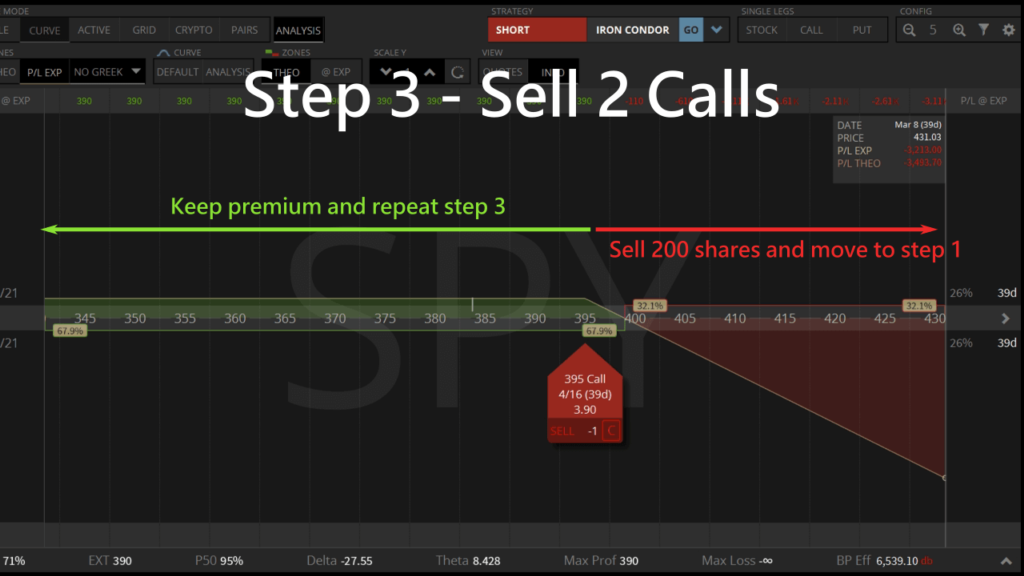
If the ETF price doesn't rise after 30 days, we collect all the premium.
If the SPY price increases beyond the Call strike, we will sell 200 shares at a high price and move back to step 1.
How to Set the Strike Prices of Put and Call?
If we look at the price history of SPY, we can see the ETF price rarely falls beyond the Bollinger Bands. So we can use the Bollinger Bands to set the strike prices for selling Puts and Calls.
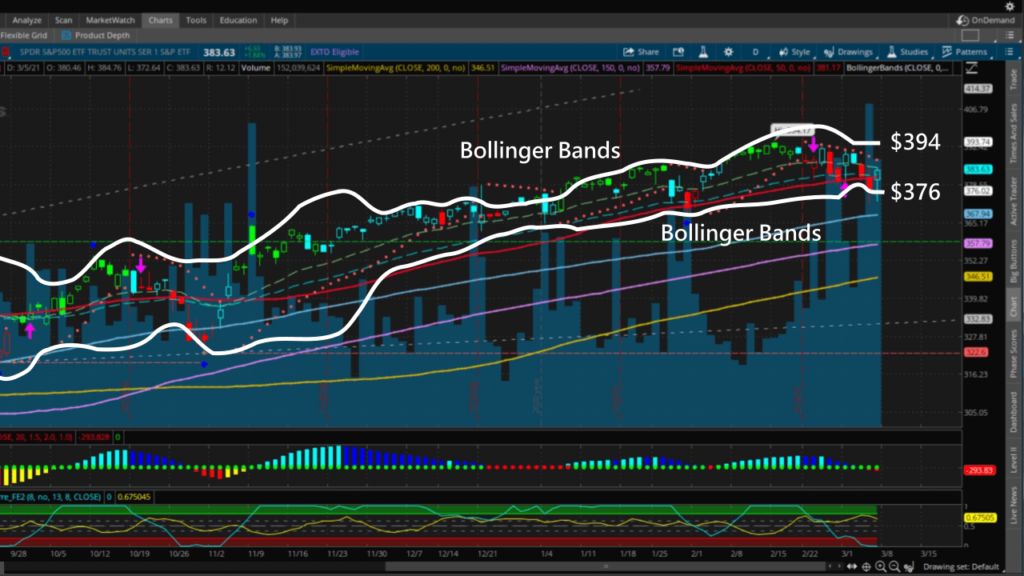
The upper and lower bounds of the SPY Bollinger Bands are currently $376 and $394, so we can use these as the strike prices for selling Puts and Calls.
Another quick way to set the Strangle prices is to use the Options Scanner to find the prices at 0.20 delta.
| Symbol | Last | Strangle details | Strangle BP | Strangle ROC |
|---|---|---|---|---|
| SPY | 383.63 | C396(0.19) P361(-0.20) | 4313 | 10.5% |
The 0.20 delta Strangle suggested by the options scanner:
- Short $396 Call and short $361 Put
- If you don't own any SPY shares, you need $4313 buying power for a 10.5% return on capital

Expected Returns of Trading the Wheel Strategy With SPY
We can use step 2 to estimate the wheel options strategy returns with SPY. If we assume the fluctuations of SPY rarely exceed our Bollinger Bands, the premium collected from $376 Put and $394 Call is around $1200 per month.
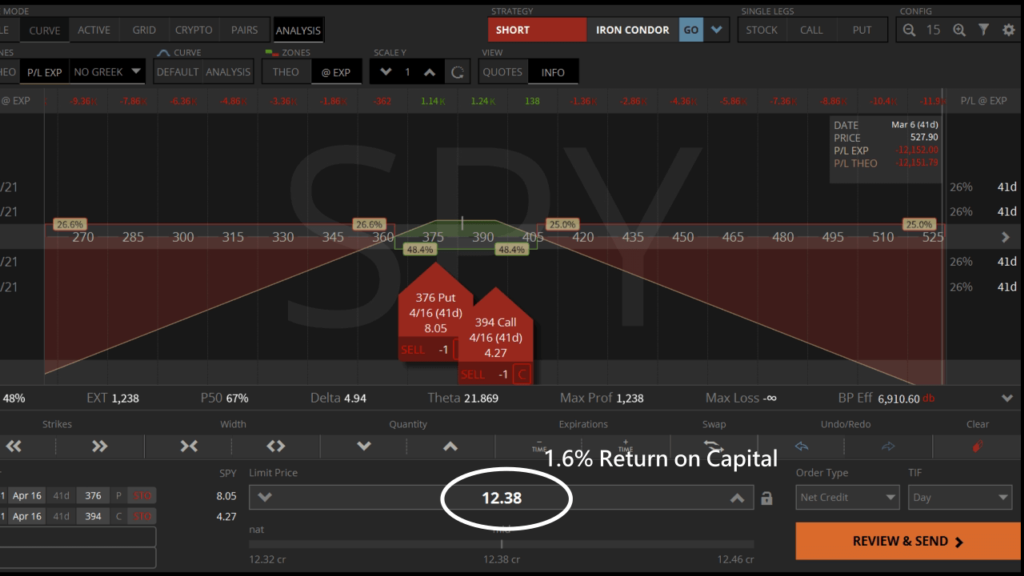
Since we set aside $77,000 cash to purchase 200 shares of SPY, the monthly return from the premium is 1.6%, which is around 19% per year.
Differences Between Holding SPY ETF and the Wheel Strategy
If buying and holding shares of SPY can expect 9% average return a year, then we can add 19% more from the premium of the Wheel Strategy, tripling our annual returns on investing in SPY.
| Strategies | Holding SPY ETF | Wheel strategy |
|---|---|---|
| Minimum cost | $383 | $77,000 |
| Annual return | 9% | 28% |
Best Value Stocks for the Wheel Strategy
We can use the Bullish Value Stocks to find a list of financially strong companies that are currently undervalued.
The list shows both Shopify and Facebook are extremely undervalued right now. They are blue-chip companies with profitable software platforms and huge competitive advantages:
- Both companies have close to 100% Upside from their respective Fair Values.
- Plus the Long Signal Days indicator shows both stocks bottomed out last week.
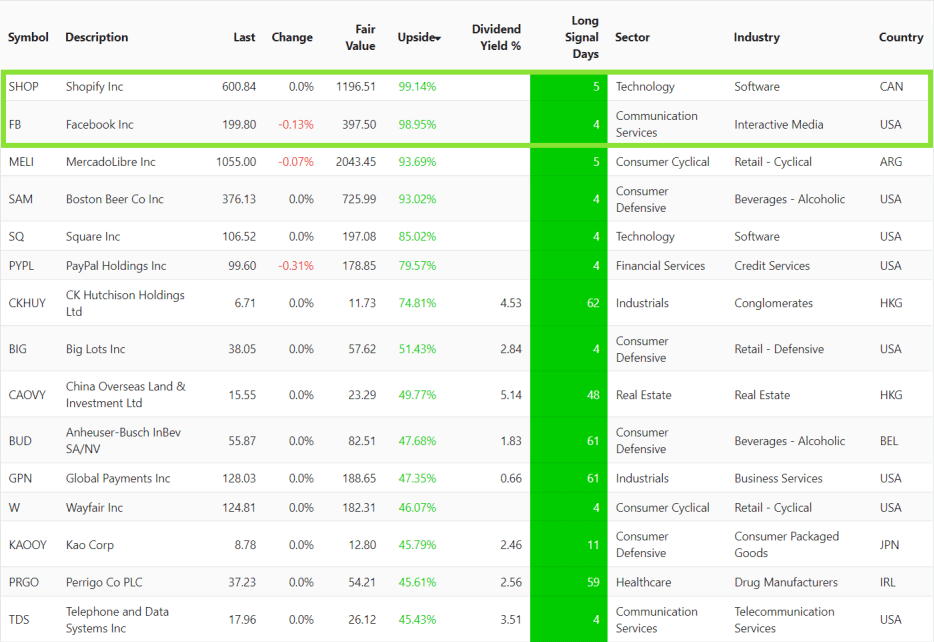
So we can trade Cash Secured Put options to SHOP and FB to earn income from the premium while anticipating an upward rebound.
SHOP's market price is currently around $600, we can sell a Cash Secured Put at 0.20 delta, $495, that expires next month. The options trade will earn us an income of $19.40 per share.
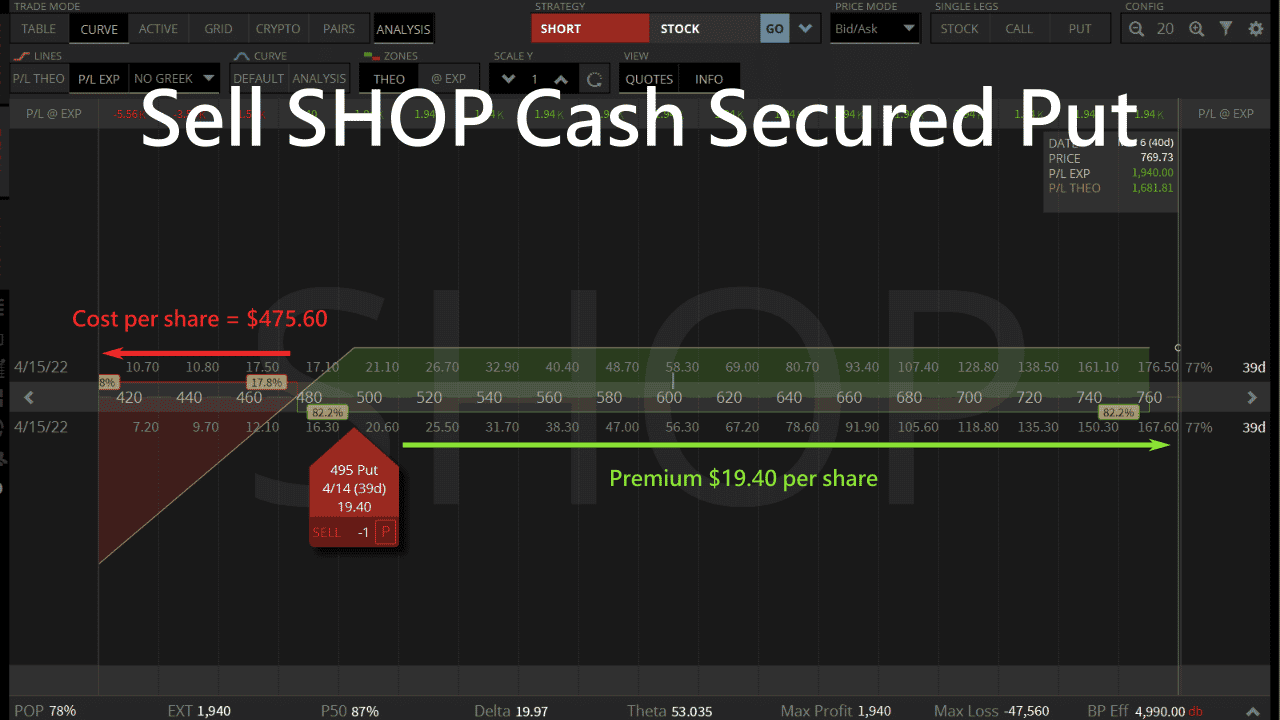
If the stock price drops, we have a chance to buy 100 shares of Shopify at $475.60, around 21% off the original price.
Meta's market price is currently around $200, a short Cash Secured Put at 0.20 delta, $175, that expires next month will receive $3.60 in premium per share.
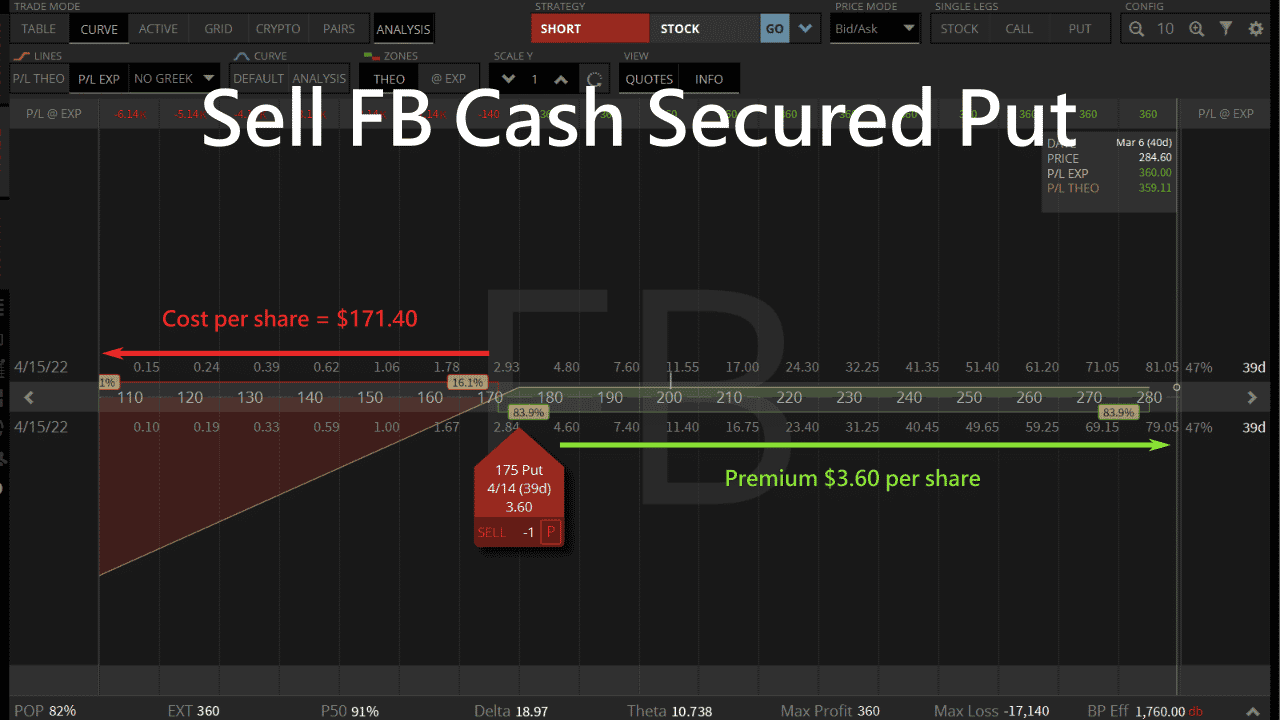
If the stock price drops, we have an opportunity to buy 100 shares of FB at $171.40, around 14% off the original price.
Both Cash Secured Put trades give us the opportunities to buy stocks at a discount. Apart from the differences in discounts, we also notice the differences in cash buying power required for the two trades.
| Stocks | Discount on stock | Cash needed |
|---|---|---|
| SHOP | 21% off | $47,560 |
| FB | 14% off | $17,140 |
The SHOP trade requires $47,560 of cash to secure each Put option contract. While the FB Cash Secured Put option requires $17,140 of buying power per contract.
Now it's your turn to use the Bullish Value Stocks to find undervalued blue-chip stocks to trade the Wheel Strategy.
Trending Articles
- What Are Options Contracts and How Do They Work?
- Options Wheel Strategy to 3x Your S&P 500 ETF Return
- 3 Things We Hate About Selling Covered Calls
- How to Roll Options to Repair Losing Trades
- How to Setup Your Telegram Username? Get Real-Time Trade Alerts
- Trade Poor Man’s Covered Call if You Can’t Afford 100 Stocks



After being assigned, would selling a straddle be more advantageous than selling a strangle?
That can work if you want to quickly move on to either step 1 or 3.
The straddle means you will always be assigned next, either sell the 100 shares or buy 100 more.
The premium received would be higher than a strangle though.
The figure showing “$376 Put and $394 Call is around $1200 per month” seems to have put/call with expiration of 41d. So the 1.6% return is for 41 days instead of one month. I am also trying to check the current SPY options, can’t find a way to achieve 1.6% monthly return. Did I miss anything?
You are right about the timeframe of the expiration, it’s an assumption.
The returns from selling neutral options are lower at the moment because VIX is quite low, which means the volatility is low.
Hence the premium received would be lower right now.
Do you think adding QQQ is a good idea or stick to SPY if you are mostly looking for safety?
QQQ has been working out for me with nice premiums and ability to roll quickly but spy feels a lot less volatile. However when looking at 10 year chart (Monthly), they seem to go hand in hand. What do you think?
I think the point of the Wheel Strategy is to balance less risks and more premiums from the options.
Both QQQ and SPY give you less risks than stocks.
While a slightly more volatile QQQ should give you better premiums and wider Call/Put strike prices.
It’s good to test the two ETFs then decide which gives a better balance for you.
Thanks for your reply.
So far I’m really enjoying SPY and QQQ and don’t have to worry about management, earnings etc
I have learned so far as you mentioned that qqq has better premiums but SPY is a bit more stable.
Covered strangle is working out nicely and adjusting positions up or down depending on market mood
Following your suggestion to use the upper and lower bounds of Bollinger bands for SPY, I come up with 404 and 418 as the strike prices for put and call, respectively. However, your options scanner for 0.20 delta indicates 386 and 427. Big difference! How can this be explained?
I double-checked the 0.20 delta suggestions on SPY, and it seems to fit with the trading platform’s numbers for expirations 7/21 and 6/16.
Can you confirm if the expirations you are looking at are the same?
If so, then the differences may be explained by the delay in data.
Hi, step number 1 considering SPY as underlying, at which delta do you recommend the first trade?
0.20 delta is a good starting point
Is the choice of the strike mainly delta or do you also consider other factors such as high premium, volatility, open interest, volume, earnings, or other?
The Options Scanner is quite useful in picking high return 0.20 delta Strangles to trade the Wheel with
https://slashtraders.com/en/tools/options-scanner/
Use the filter to find high IV stocks (>60%) that have high premium to sell options with, and sort by Strangle ROC to get the best return Strangles
When you’re in Step 1 of the Wheel, you’re selling only one cash-secured put, which means collecting only one premium. The other two steps involve collecting two premiums. Is it advisable to sell two puts in the beginning, or else one put with a strike price closer to the stock price, in order to increase the premium?
If you sell 2 cash-secured Puts in step 1, you will need to double the contracts in steps 2 and 3 later as well.
Selling a Put with a closer strike is preferable from the two choices you mentioned.
Why are you adding the theoretical pct return to the buy and hold return to come up with 28%? If you’re doing the whell strategy ur not realizing the 9% gain from buy and hold, ur in and out of the ETF, so I’m not understanding your math.
28% is a hypothetical return based on step 2, sell a Strangel while holding 100 shares:
Buying and holding the ETF, gaining 9%/year
Both short Put and short Call options expire worthless, receiving a premium of around 19%/year
Hi, is there any ready etf that do all this mechanics?
Not that I know of.
Tony您好
我看了您兩篇文章
第一篇是「滾輪投資策略」
第二篇是「我們不愛交易Covered Call的理由」
然而我們都知道,「滾輪」必然會使用到「covered call」,您這樣不就是自相矛盾嗎?
建議您修改一下「covered call」的標題,不要誤導那些不太懂選擇權,但信任您的人。
謝謝您的留言
Covered Call雖然好上手,不過有幾個缺點讓我們不太愛交易它
我們誠實分享我們的想法讓讀者做決定
Hi Tony,
I have been trying wheel strategy with paper money. At what point do we need to cut losses if the stock moves below the put strike? since we will be paying more than the spot price at assignment.
Are there any adjustments that should be considered?
Thanks
Vishal
Hi Vishal,
Actually, we prefer to trade wheel strategy on stocks that we want to buy and hold for the long term.
So we don’t mind buying the stocks when the spot price moves below the Put.
If we anticipate the blue-chip stock to be valuable in the long run, a temporary dip isn’t that big of a deal.
We just keep selling the Covered Call until we sell the shares for a profit.
Cheers
How do we avoid the “Wash-Sale” in short cycles (monthly or weekly) when ETF keep getting assigned?
After you get assigned the undervalued shares you can sell Covered Calls with monthly expiration as the underlying moves from significantly undervalued to significantly overvalued.
When an underlying is 30-40% overvalued, you can start selling at 0.15-0.40 delta Covered Calls.
The transition of the underlying from undervalued to overvalued takes a long time and will not be at risk with the wash-sale rules.
Should your underlying be called away, you will not regret it too much because your gain from valuation has been significant.
Hi, if let’s say now we are holidng 200 shares of SPY and SPY crashed, how do we set the strike price for selling calls as we are still in capital loss?
Thanks in advance.
It depends.
If you expect SPY to bounce back quite quickly, then you can set the Call strike at the breakeven price.
If you expect SPY to stay low for a while, then maybe set the Call strike at 0.20 delta (assuming that is lower than the breakeven price), to earn a better premium.
Hi Tony, wow – not complicated but highly effective, thank you so much!
Would it be a advantage to use the weekly contracts in SPY, for example always Friday?
Hi Chris,
We prefer trading monthly options because the theta decay is more predictable, leading to higher probability trades.
We don’t trade weekly contracts because the time to expiration is too short, as that would mean trading gamma not theta.
Gamma is much more unpredictable than theta.
Also, weekly options have less premium due to less time value, so you don’t get as much income from selling options.
What if I own 500 stocks?
Sell 400 calls and one strangle?
Yes, selling 4 Covered Calls and 1 Strangle can work in your situation.
The wheel strategy does seem like a great way to increase my returns on dividend stocks
Yes, you can combine the wheel with high yield dividend stocks to improve your returns
如果卖put被assign了?被assign的股票又在持续下跌,碰到这种情况卖call的话, strike price应该设在哪个位置比较好?设太高,premium赚不了多少,设太低,那股票可能低价卖掉,造成亏损。
如果不想长期持有股票,当Put被assign了的时候,可以卖一个Call在当初Put的strike
这样收入应该还够高,如果股价涨回来就会回本
On what chart are you using the bollinger bands? Because it is different if you use a year chart, 5 year, or 180 days?
We use the Bollinger Bands on the daily chart
It’s an estimation of 2 standard deviation move
Shouldn’t matter too much if you use a year chart, 5 years, or 180 days
你好TONY。。。如果選擇STRIKE的时候刚刚BOLLINGERBAND是在常窄,選擇的STRIKE也非常緊貼現貨價。。。這樣不是會很危險嗎?因為Bollinger Band在收窄之後,很自然的會擴闊到很大!!!這樣的話,不是很容易輸錢嗎??
您好Eric
是的所以我們通常要在Bollinger bands比較短的時候賣期權收入比較高,也可以等IV縮小時靠Vega獲利
这个方法在市场暴跌的时候适用吗
这个交易方式在市场暴跌的时候会以低价买到100股
接下来就可以用卖Call的方式赚收入等待股价上涨
This is a great options strategy, thanks
You’re welcome
Thank you for the detailed explanation of how to use the wheel strategy to increase the returns of my SPY
Yes, the wheel strategy is a simple way to use options to increase your long term returns
Current prices for calls/puts (as of mid Oct 2021) doesn’t yield such high returns and wouldn’t bring you any where close to 1.6%.
Have the markets changed so much or am i looking at it wrong?
Market has changed a lot over the course of this year. Volatility (VIX) has come down to 16.30 as of today. During the crash last year, VIX peaked at around 80. The historical level is between 11-16. When you consider the current ROC level as not interesting for selling covered calls, it is the normal market environment and return profile that you will be confronted with going forward. You can better sell put and call spreads at the money with much higher ROC because in these cases you are selling at-the-money volatility which is the highest point of volatility of any underlying. The put and call spread scanners are great tools to find such ATM trades. It is not easy to find ATM trades with high probability of success because it is a directional trade with high rewards. I do not trade any covered calls because ROC is low and you don’t want your patiently acquired stocks to be called away and after that the stocks moves another 5% without you owning it. Covered calls is easy to comprehend for beginners as a low risk strategy but doesn’t get you anywhere.
Thank you for this great S&P 500 trading strategy, looks like a great way to accelerate the returns of my SPY long term investment strategy.
Thank you for your kind words.
Please give this S&P 500 trading strategy a try and let me know your results.
Thank you for sharing a comparison of the wheel strategy vs buy and hold
I’ll be using the wheel strategy to improve the returns of my buy and hold stocks from now on
Please give the wheel strategy a try, you’ll love it
What is the characteristics for your billing we bands
You can sign up for our affiliate program to be a partner.
這個交易模式好適合選擇權新手試試看!
是啊,只要挑選波動不大的ETF或股票就可以搭配賣選擇權增加收入
Hi, interesting strategy. Have you the strategy backtest? If yes, what are the results?
Here is an interesting video from Tastytrade that backtested stock vs Puts, which should answer half of the equation.
https://www.tastytrade.com/shows/market-measures/episodes/puts-or-stock-07-09-2018
Thank’s for the link.
謝謝好文章篇分享,受益良多
Thank you for the tip
This sounds like a good strategy for MSFT
I definitely would like to own more MSFT stocks at a discount
You are right!
The Wheel Strategy is great for financially strong companies like MSFT and FAANG.
很好的操作模式,想進一步請教有那些股票是適合操作標的?
Hi,如文章提到的The Wheel Strategy主要是用賣期權的收入增加長期持有股票或ETF的投資報酬率
所以使用滾輪投資時建議使用在:
1.你願意長期持有的股票/ETF
2.波動不大的股票/ETF(以免大波動讓股價超越履約價太多,損失價差)
所以建議使用在FAANG等有競爭力又長期成長的優質股票
和S&P 500的ETF,例如VOO、IVV等
非常感謝!
How about TNA and SOXL?
Hi Simon, thank you for getting in touch.
Yes, I think TNA and SOXL are also good candidates for the Wheel Strategy, since they are ETFs that tend to be less volatile than individual stocks.
Their lower prices also mean you need less capital than SPY to execute the Wheel.